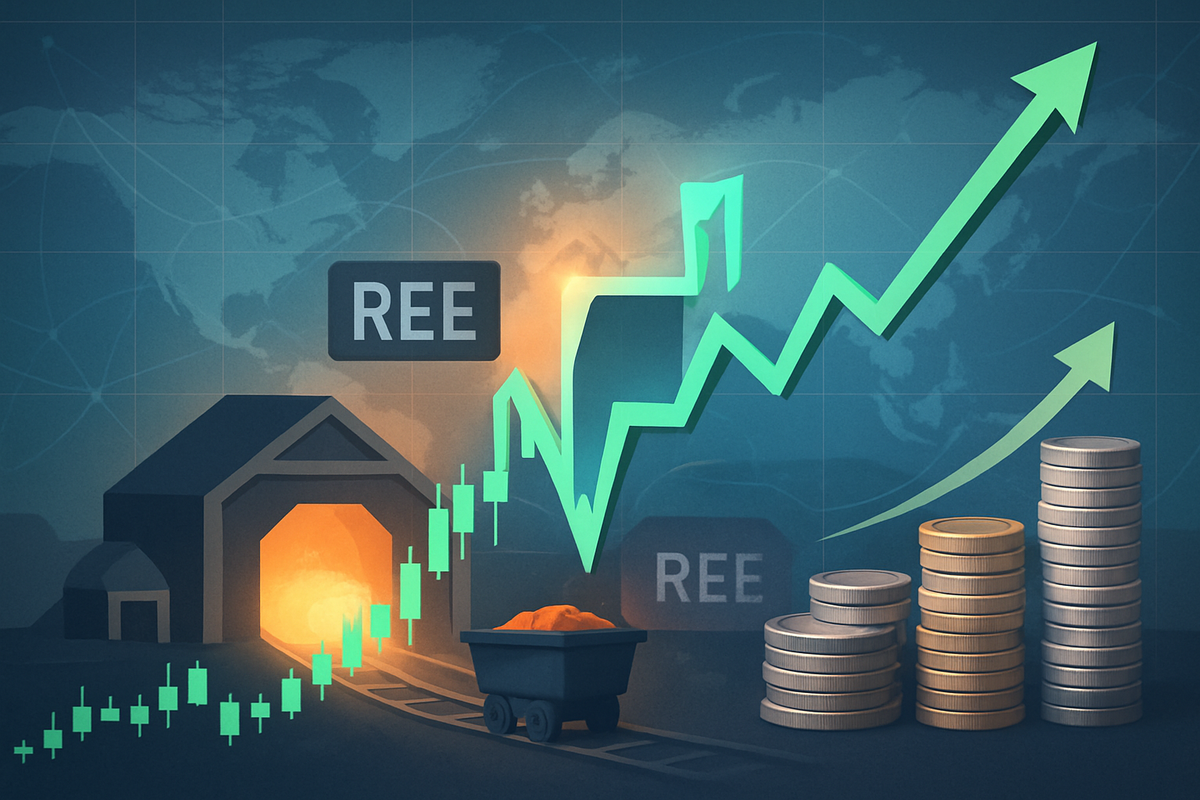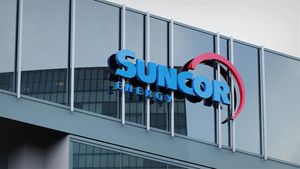
Ramaco Resources (NASDAQ: METC), a name traditionally associated with metallurgical coal, has recently captured significant market attention with its shares experiencing multiple "gap up" events. These surges, particularly evident in late 2024 and 2025, signal a profound shift in investor perception, driven not only by a strategic entry into the critical rare earth elements (REE) market but also by a recent dividend increase. The company's evolving profile beyond conventional coal production is positioning it as a key player in the domestic supply chain for essential minerals, a development with immediate and far-reaching implications for the coal and broader metals sector.
Drivers Behind the Ascent: Rare Earths, Dividends, and Geopolitical Shifts
Ramaco Resources' stock has demonstrated remarkable upward momentum through several "gap up" events, reflecting a confluence of strategic developments and market dynamics. On October 13, 2025, Ramaco Resources' shares gapped up significantly, opening at $19.74 after closing the previous session at $18.32, eventually trading at $19.68. This positive movement was partly bolstered by a recent increase in the company's quarterly dividend, from $0.18 to $0.1918, paid on September 19, 2025, signaling financial health and a commitment to shareholder returns.
A more dramatic surge occurred on October 10, 2025, when the stock gapped up to $43.54 from a previous close of $41.49, trading as high as $46.12. This particular spike was directly attributable to China's Commerce Ministry tightening its control and oversight of rare earth exports, requiring shipments of certain rare earths to obtain an export license. This geopolitical move immediately highlighted the strategic importance of non-Chinese rare earth producers, thrusting Ramaco Resources and its Brook Mine in Wyoming into the spotlight as the first new rare earth element operation in the U.S. in 70 years. Earlier in the year, on September 15, 2025, the company had already seen a substantial 7.88% gain, reaching an intraday high of $26.29, contributing to an impressive 190.99% increase over the preceding month and a 174.75% year-to-date performance. Even as early as June 30, 2025, shares had soared 6.1% to close at $12.2, supported by strong trading volume.
These events have led to significant price appreciation and heightened trading volume, reflecting robust market interest and investor confidence. The renewed focus on REE, particularly after China's export restrictions, has positioned Ramaco's Brook Mine as a critical national asset. This strategic pivot has even seen some analysts revise price targets upwards, with Jefferies Financial Group, for instance, raising its price target to $45.00 with a "buy" rating in September 2025. This positive sentiment persists despite the company reporting quarterly losses, such as a ($0.29) EPS for the quarter ending July 31, 2025, suggesting that strategic assets and growth prospects in critical minerals are currently outweighing short-term financial performance in driving investor interest.
Shifting Fortunes: Winners and Losers in the New Landscape
The recent movements in Ramaco Resources' (NASDAQ: METC) stock, particularly its strategic pivot into rare earth elements, are creating a ripple effect across the coal and metals sector, delineating clear winners and potential losers.
Ramaco Resources (NASDAQ: METC) stands as the primary beneficiary. Its Brook Mine in Wyoming, identified as the first new rare earth element operation in the U.S. in 70 years, has become a cornerstone of its valuation. The company's ability to extract and process rare earth elements from its metallurgical coal byproducts positions it uniquely in the domestic supply chain. This strategic asset reduces U.S. reliance on foreign, particularly Chinese, sources for critical minerals, attracting significant investor interest and potentially government support. The recent dividend increase further enhances its appeal to income-focused investors, solidifying its position as a growth-oriented company with shareholder returns in mind.
Other domestic rare earth and critical mineral developers are also likely to benefit from the intensified focus on supply chain diversification. Companies like MP Materials (NYSE: MP), which operates the Mountain Pass mine, or emerging players in the critical minerals space, could see increased investor attention and potential government funding as the U.S. and its allies seek to secure their supply of these essential materials. The geopolitical emphasis on reducing dependence on China for REEs creates a favorable environment for any entity capable of contributing to a robust domestic supply chain.
Conversely, companies heavily reliant solely on thermal coal production might find themselves at a disadvantage. While metallurgical coal, Ramaco's traditional business, still has a strong long-term outlook due to steel demand, the broader coal market faces pressure from the global energy transition. Companies without a diversified portfolio or a strategic pivot into critical minerals or other high-demand commodities may struggle to attract the same level of investor enthusiasm seen by Ramaco. Furthermore, Chinese rare earth producers and exporters could face long-term challenges. China's tightening of export controls, while initially driving up prices for some rare earths, also accelerates global efforts to find alternative sources. This could lead to a gradual erosion of their market dominance as other nations invest heavily in their own rare earth extraction and processing capabilities.
The event also highlights a broader trend: diversification is key for survival and growth in the mining sector. Companies that can adapt to evolving global demands, leverage technological advancements for byproduct extraction, and strategically position themselves in critical supply chains are poised to thrive. Those that remain rigid in their traditional offerings without exploring new opportunities in the critical minerals space might see their market share and investor appeal diminish over time.
Broader Implications: Geopolitics, Green Transition, and Market Realignments
Ramaco Resources' (NASDAQ: METC) recent surge and strategic pivot into rare earth elements (REE) are not isolated events but rather indicative of profound shifts within the global financial and industrial landscape. This development fits squarely into several broader industry trends, most notably the escalating geopolitical competition for critical minerals and the accelerating global push for supply chain resilience.
The geopolitical significance cannot be overstated. China's tightening of rare earth export controls in October 2025 serves as a stark reminder of the strategic vulnerability faced by nations dependent on a single source for these essential materials. REEs are vital for a vast array of high-tech applications, including electric vehicles, renewable energy technologies, defense systems, and advanced electronics. Ramaco's Brook Mine, positioned as a domestic U.S. source, directly addresses this national security imperative. This event will likely accelerate initiatives by the U.S. government and its allies to fund and incentivize domestic critical mineral production, potentially leading to new policy frameworks, subsidies, and international collaborations aimed at diversifying supply chains away from China.
The ripple effects on competitors and partners are substantial. For traditional metallurgical coal producers, Ramaco's success in REE extraction from coal byproducts could serve as a blueprint or a competitive challenge. Companies that possess similar geological assets might be spurred to explore their own critical mineral potential, leading to a wave of research and development in byproduct recovery. Partners in the steel industry, particularly those in the U.S., will benefit from a more secure domestic supply of metallurgical coal and potentially, a domestic source of REEs, reducing their exposure to volatile international markets and geopolitical risks. Conversely, companies that fail to innovate or diversify could see their competitive edge erode.
Regulatory and policy implications are also significant. The U.S. government, through agencies like the Department of Energy and Department of Defense, has been actively promoting domestic critical mineral production. Ramaco's progress will likely reinforce calls for streamlined permitting processes, increased funding for mineral processing technologies, and potential trade protections for domestic producers. This could manifest in legislation aimed at securing critical mineral supply chains, similar to existing policies for other strategic commodities.
Historically, this situation echoes past resource nationalism movements and strategic mineral races, such as the scramble for oil in the 20th century or the Cold War-era focus on uranium. The current emphasis on REEs and other critical minerals represents a modern iteration of this competition, driven by the demands of the green energy transition and advanced manufacturing. The difference now is the added layer of environmental and social governance (ESG) considerations, which will influence how these new mines are developed and operated. Ramaco's ability to extract REEs from an existing coal operation might offer a more environmentally palatable approach compared to developing entirely new greenfield REE mines.
The Road Ahead: Opportunities, Challenges, and Strategic Pivots
The landscape for Ramaco Resources (NASDAQ: METC) and the broader critical minerals sector is poised for dynamic shifts in the short and long term, presenting both significant opportunities and notable challenges.
In the short term, Ramaco is likely to experience continued investor interest, especially as geopolitical tensions surrounding rare earth elements persist. The company's immediate focus will be on advancing its Brook Mine rare earth project, moving from resource identification to pilot plant operations and eventually commercial production. Securing off-take agreements with domestic manufacturers and potentially government entities will be crucial for de-risking the project and ensuring a stable revenue stream. Market opportunities include leveraging its early-mover advantage in domestic REE production to command premium pricing and attract further strategic investments or partnerships. Challenges might include the technical complexities of scaling up REE extraction, securing necessary permits, and navigating potential price volatility in both metallurgical coal and rare earth markets.
Looking at the long term, Ramaco's strategic pivot could fundamentally transform its business model, potentially shifting its primary identity from a coal producer to a critical minerals supplier. This would entail continued investment in REE processing technologies, expansion of its rare earth resource base, and potentially exploring other critical minerals within its geological footprint. The long-term market opportunities are immense, driven by the accelerating global demand for electric vehicles, renewable energy infrastructure, and advanced defense technologies, all of which rely heavily on rare earths. Ramaco could become a cornerstone of the U.S. critical minerals supply chain, potentially leading to further vertical integration or diversification into downstream processing.
However, potential strategic pivots or adaptations will be required. The company may need to continuously invest in research and development to optimize extraction efficiencies and reduce environmental impact, aligning with evolving ESG standards. Adapting to fluctuating metallurgical coal prices while simultaneously developing a new, capital-intensive rare earth business will require astute financial management. The competitive landscape for rare earths is also evolving, with other nations and companies investing in their own domestic sources, which could introduce new competition in the long run.
Potential scenarios and outcomes vary. In an optimistic scenario, Ramaco successfully scales its REE operations, becoming a dominant domestic supplier, and its stock price reflects this enhanced valuation, leading to further dividend increases and shareholder value. In a more challenging scenario, technical hurdles or market oversupply in the future could slow the rare earth project's progress, leaving the company still heavily reliant on the cyclical metallurgical coal market. The most likely outcome is a hybrid approach, where Ramaco gradually transitions, balancing its established metallurgical coal business with the promising, but capital-intensive, rare earth venture, steadily increasing its critical minerals footprint over the next decade.
MarketMinute Wrap-Up: A New Chapter for Ramaco and the Critical Minerals Market
Ramaco Resources' (NASDAQ: METC) recent share surges mark a pivotal moment, not just for the company but for the broader financial markets observing the evolving dynamics of the energy and critical minerals sectors. The key takeaway is the successful strategic diversification of a traditional coal producer into the high-growth, geopolitically critical rare earth elements (REE) market. This move, coupled with a shareholder-friendly dividend increase, has fundamentally re-rated Ramaco in the eyes of investors, demonstrating the significant value creation possible through innovation and strategic adaptation.
Moving forward, the market will increasingly assess companies not just on their current output but on their potential to contribute to secure and sustainable supply chains for the future economy. Ramaco's ability to extract REEs from its existing metallurgical coal operations positions it uniquely to capitalize on the urgent need for domestic critical mineral sources, especially in light of tightening export controls from dominant producers like China. This event underscores the growing importance of resource nationalism and the strategic imperative for nations to cultivate their own critical mineral capabilities.
For investors, the significance of this shift cannot be overstated. Ramaco has transformed from a purely cyclical metallurgical coal play into a hybrid growth story with exposure to the strategic critical minerals sector. This provides a more resilient and diversified investment thesis. What investors should watch for in the coming months includes further updates on the progress of the Brook Mine rare earth project, specifically milestones related to pilot plant operations, permitting, and potential off-take agreements. Additionally, any further geopolitical developments impacting rare earth supply chains will be crucial, as these will directly influence the strategic value and pricing power of domestic producers like Ramaco. Finally, continued monitoring of metallurgical coal prices will still be important, as this remains a significant part of the company's current revenue base.
This content is intended for informational purposes only and is not financial advice





